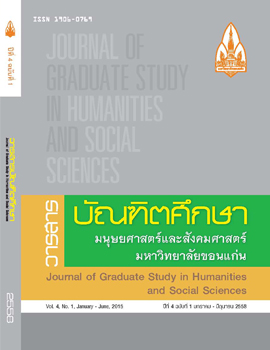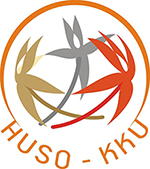คำบุรุษสรรพนามของชาวไทยพวนภาคอีสาน
Keywords:
คำบุรุษสรรพนาม, ไทยพวน, ภาษาถิ่น, Personal pronoun, Thai-Phuan, DialectAbstract
การวิจัยนี้มีวัตถุประสงค์เพื่อศึกษาคำบุรุษสรรพนามของชาติพันธุ์ไทยพวนในภาคอีสานและเพื่อเข้าใจว่าไทยพวนมีการใช้คำบุรุษสรรพนามอย่างไร กลุ่มตัวอย่างในการวิจัยนี้ แบ่งออกเป็น 3 กลุ่ม อายุ ได้แก่ 15 - 25 ปี 35 - 45 ปี และ 55 - 65 ปี โดยมีพื้นที่วิจัย 3 แห่ง ได้แก่ 1) หมู่บ้านบุฮมอำเภอเชียงคานจังหวัดเลย 2) หมู่บ้านถ่อน อำเภอบ้านผือ จังหวัดอุดรธานี และ3) หมู่บ้านโพธิ์ตาก อำเภอโพธิ์ตาก จังหวัดหนองคาย ซึ่งรวบรวมข้อมูลด้วยการใช้แบบสอบถามการสัมภาษณ์และการบันทึกเทป
ผลการวิจัยแสดงให้เห็นว่ากลุ่มไทยพวนมีการใช้คำบุรุษสรรพนามทั้งหมด 193 คำ แบ่งออกเป็น 3 กลุ่ม ตามบุรุษสรรพนาม ได้แก่ สรรพนามบุรุษที่ 1 จำนวน 42 คำ สรรพนามบุรุษที่ 2 จำนวน 95 คำ และสรรพนามบุรุษที่ 3 จำนวน 56 คำ ปัจจัยทางสังคมที่ใช้ในการวิเคราะห์การใช้คำสรรพนาม ได้แก่ เพศและอายุของคู่สนทนา กาลเทศะ ความเป็นเครือญาติ ความสนิทสนม ความสุภาพ และการแสดงอารมณ์
โดยปัจจัยด้านเพศแบ่งเป็นเพศชายและเพศหญิง ปัจจัยด้านอายุแบ่งเป็นอายุน้อยกว่าและอายุมากกว่า กาลเทศะแบ่งเป็นความเป็นทางการและไม่เป็นทางการ ปัจจัยด้านความสนิทสนมแบ่งเป็นความสนิทสนมและไม่สนิทสนม ส่วนปัจจัยด้านความสุภาพแบ่งเป็นความสุภาพและความไม่สุภาพ และการแสดงอารมณ์แบ่งออกเป็นอารมณ์พึงพอใจและอารมณ์ไม่พึงพอใจ
ผลการวิจัยยังเผยให้เห็นถึงว่าชาวไทยพวนในภาคอีสานยังคงรักษาและใช้คำบุรุษสรรพนามทั้ง กลุ่มของตนเองไว้ นอกจากนี้ยังพบว่ามีการปนคำบุรุษสรรพนามที่มาจากภาษาเลย และภาษาถิ่นอีสานและไทยกลางร่วมด้วย
The Personal Pronoun ofThai-Phuanin Isan Region
This research aims to studythe personal pronouns of the Thai-Phuan ethnic group in Isan region and to understand how they use their personal pronouns. The sampling is divided into 3 groups by age; 15 - 25 years old, 35 - 45 years old and 55 - 65 year old.There are 3 areas of this study namely 1) Buhom village, Chiang Khan district, Loei province, 2) Thon village, Ban Phue district, Udonthani province, and 3) Pho Tak village, Pho Tak district, NongKhai province.The data were collected by questionnaires, informant interview and video recording.
The results were showed that Thai-Phuan people totally used 193 personal pronouns which are classified into 3 types; 42 first person pronouns; 95 second person pronouns and 56 third person pronouns. Social factors analyzed using pronouns; gender and age of interlocutor,circumstance, relative, familiarity, politeness, and emotional expression.
Genders involve males and females. Ages involve younger and older. Circumstance consists formal and informal. Relatives involverelative and non-relatives. Familiarity involves familiarity and unfamiliarity. Politeness involves politeness and impoliteness. Emotion expressions consisted of satisfaction and dissatisfaction.
The research finding was illustrated that Thai-Phuan people in Isan regionhave remained all 3 types of personal pronouns. In addition, they also have mixed the personal pronouns from Loei sub-dialect, Isan dialect and Central Thai dialect.







